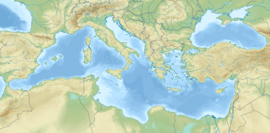geo.wikisort.org - Island
The Hellenic arc or Aegean arc is an arcuate mountain chain of the southern Aegean Sea located on the southern margin of the Aegean Sea Plate. Geologically it results from the subduction of the African Plate under it along the Hellenic subduction zone. The Hellenic Trench trends parallel to its southern side. The Aegean Sea Plate, a microplate, is often considered part of the Eurasian Plate from which it is in the process of diverging. The arc itself is mainly marine, the mountaintops appearing as islands in the Ionian Sea, Crete and its environs, or in the Dodecanese group. It encroaches on mainland terrain in the Peloponnesus, on Crete, on Rhodes, and on the southern coast of Anatolia, thus being encompassed by both Greece and Turkey.
 A combined diagram of the Aegean and Anatolian Plates. The southern margin of the Hellenic arc is shown, which is the trend line of the faults separating the arc and the Hellenic Trench. The body of the arc is the chain called the outer Hellenides, which includes west Peloponnesus, Crete, Rhodes, southwestern Turkey, and all the islands between. | |
| Etymology | Republic of Hellas (Greece) |
|---|---|
| Geography | |
| Location | The center of Crete is at about center of the arc |
| Coordinates | 35°12′50″N 24°58′01″E |
| Archipelago | southern outer Hellenides |
| Adjacent bodies of water | Aegean Sea, Ionian Sea, Mediterranean Sea |
| Administration | |
Greece | |
The direction of subduction is northward. Locations on the arc or near it on the north side are therefore called "outer" as they are at the outer margin of the plate. Locations further north are "inner." Generally the motion of subduction is from outer to inner. It so happens that, due to back-arc extension, the Hellenic Arc and Trench are moving in the reverse direction, from inner to outer, accounting for the severe arcuate form. There are in essence two layers at the subduction zone, a bottom one moving from outer to inner, and a top one moving from inner to outer.
The extension of the top layer required for this excursion of the arc and the trench comes from thinning of the back-arc ("in back of the arc"), weakening the crust there. There was already a mountain chain north of the arc, a legacy from the Alpine Orogeny, called the "inner arc." Its tops are the Cyclades. In addition, a chain of volcanos has appeared across it, due to magma breaking through the weakened crust; hence, this "inner arc" is termed the South Aegean Volcanic Arc. The two arcs are considered distinct, being from different orogenies. The term "Hellenic Arc" most often refers to the marginal, or "non-volcanic" arc, also called the Aegean forearc in the direction from outer to inner, which is consonant with the Hellenic Trench being the foredeep.
Geometry of the Hellenic arc
The Hellenic arc extends from the Ionian islands in the west to just east of the island of Rhodes in the east, where it links to the Cyprus arc.
Development
The current geometry of the Hellenic arc is a result of the southwards migration of the subduction zone.[1] This has led to extension both along the line of the arc as it bulged out and extension perpendicular to the arc, which is the current tectonic state.
Seismicity
The Hellenic arc is one of the most active seismic zones in western Eurasia.[2] It has regularly been the source for magnitude 7 earthquakes in the last hundred years of instrumental recording and the location for at least two historical events that were probably of about magnitude 8 or more, the 365 Crete earthquake and the 1303 Crete earthquake.[3]
See also
- Mediterranean Ridge
References
- ten Veen, J.H.; Kleinspehn, K.L. (2003). "Incipient continental collision and plate-boundary curvature: Late Pliocene–Holocene transtensional Hellenic forearc, Crete, Greece". Journal of the Geological Society. 160 (2): 161–181. Bibcode:2003JGSoc.160..161T. doi:10.1144/0016-764902-067. Retrieved 26 July 2010.
- Papadopoulos, G. A.; Ganas, A.; Karastathis, C. (2004). "Seismicity Properties as a Marker of the Active Plate Convergence in the western Hellenic Arc". American Geophysical Union, Fall Meeting Abstracts. 53: 0483. Bibcode:2004AGUFM.T53B0483P.
- USGS (29 March 2010). "Tectonic Summary of Greece". Retrieved 26 July 2010.
External links
![]() Media related to Hellenic arc at Wikimedia Commons
Media related to Hellenic arc at Wikimedia Commons
На других языках
[de] Hellenischer Inselbogen
Der Hellenische Inselbogen oder auch Ägäische Inselbogen, Englisch Hellenic Arc, ist eine im östlichen Mittelmeer gelegene Inselbogen-Struktur, die aus der Subduktion der Afrikanischen Platte unter die Ägäische Platte hervorgegangen ist. Die nordöstlich-südwestliche Relativbewegung der beiden Platten erfolgt mit einer Geschwindigkeit von 50 Millimeter pro Jahr.[1] An der Außenseite des Inselbogens in Richtung Afrika liegt der Hellenische Tiefseegraben, eine durch die Subduktion verursachte Tiefseerinne. Auf der Innenseite befinden sich zwei voneinander getrennte Bögen — ein nichtvulkanischer äußerer und ein vulkanischer innerer Bogen, der Kykladenbogen. Die nördlich anschließende Ägäis bildet ein an der Innenseite des Inselbogens gelegenes Randmeer.- [en] Hellenic arc
Другой контент может иметь иную лицензию. Перед использованием материалов сайта WikiSort.org внимательно изучите правила лицензирования конкретных элементов наполнения сайта.
WikiSort.org - проект по пересортировке и дополнению контента Википедии

